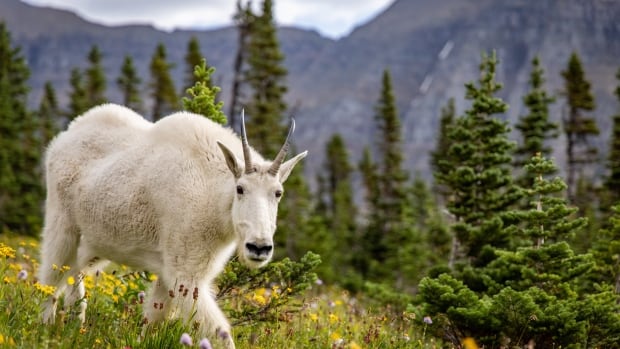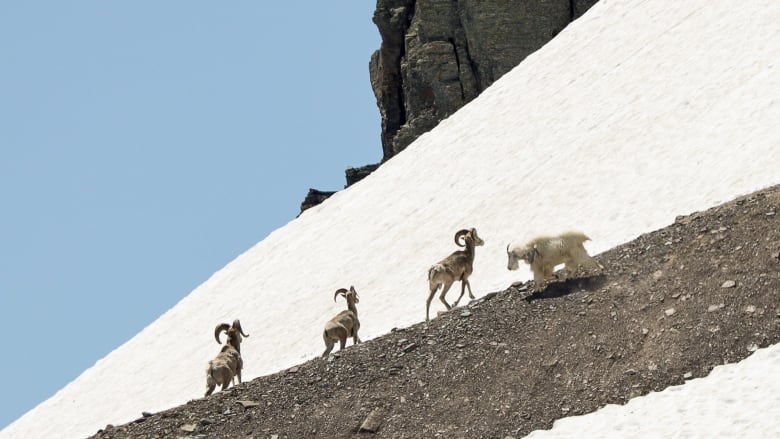
As It Happens6:36When goats and sheep compete for tasty mountain salt, goats almost always win
As climate change causes glaciers to melt, two high-climbing species are competing over who gets to lick up all the nutritious salt deposits left in their wake.
Bighorn sheep and mountain goats both want a piece of these previously unavailable mineral deposits, and scientists have been watching them to see who comes out on top.
“I figured that, hey, they’re the same size. About half the time, sheep will win, half the time, goats will win,” Colorado State University wildlife ecologist Joel Berger told As It Happens host Nil Köksal.
But, in fact, in more than 100 such interactions, was the goats about 98 per cent of the time.
“Sheep won a measly two or three of the interactions,” Berger said. “That shows you scientists are not always the most prudent or insightful, because I was wrong.”
Berger, a senior scientist for the Wildlife Conservation Society, is the lead author of a new study exploring the high-altitude phenomenon. The findings were published this week in the journal Frontiers of Ecology and Evolution.
Mostly just ‘sabre-rattling’
Berger first happened upon these contests in Montana’s Rocky Mountains while he and doctoral student Forest Hayes were out looking for grizzly bears.
They were peering through small telescopes, when they noticed a group of goats walking across the rocky landscape toward what looked like a pile of dirt. About 400 metres away, they saw a group of sheep headed in the same direction.
That dirt pile, it turned out, was a mineral lick — a salt deposit packed with nutrients.
“They were licking the ground. Some were moving toward the others, and the others were then moving away. And it became clear after a couple of hours they were competing, and each species wanted to lick from the same spot,” Berger said.

But these competitions, Berger said, weren’t exactly ferocious battles. The goats could scare the sheep away by waving around their intimidating horns, or just walking towards them aggressively, or occasionally charging.
“It’s not like blood, guts, red tooth and claw. It’s more like maybe a big bully approaching some kids at the playground,” Berger said.
“The bully waves his arm or her arm, whichever the case may be, and the kids go running off because they don’t want to interact.”
Berger and his colleagues decided to study the interaction between the two species further, focusing their observations on three alpine sites: Mount Evans in Colorado; Glacier National Park in Montana, straddling the Canadian border; and Caw Ridge in Alberta.
They conducted their own field research at the two U.S. sites, and used data from Canadian wildlife ecologist
Frédéric Dulude-de Broin, who studied mountain goats for his master’s thesis and sometimes observed them interacting with bighorn sheep.
“It showed that it was the same pattern,” Berger said. “The goats clearly dominated in all instances.”
The complex consequences of climate change
The findings, Berger said, paint a complex picture of the effects of climate change on the goats and sheep. Glaciers are melting at a rapid rate and unveiling new sources of much-needed nutrients.
“We might argue, hey, this is a positive thing because they’re finding or accessing these minerals,” he said.
On the other hand, he says both creatures are being increasingly deprived of much-needed nutrient sources elsewhere, as both road building projects and wildfires reduce their access to lower-altitude mineral deposits.
“If that’s happening at the higher elevations, the lower elevations are getting fried,” he said.
What’s more, these mountainous salt licks are rare and far-scattered, which means the goats and sheep have to travel long distances just to access them. And sometimes, in the case of the sheep, the journey may not pan out.

Tyler Jessen, a PhD candidate at the University of Victoria who was not involved with this research, called it an “interesting study and one that touches on important nuances in the study of environmental change.”
Jessen’s research focused on how environmental changes affect animal populations, and he has previously studied the decline of mountain goats in Canada.
He says his field of science often focuses on one species at a time, to reduce complexity. He credited Berger and his colleagues for exploring how environmental changes also impact interaction between species.
“The authors of this study … shed important light on how competition among species over limited resources might occur — a context that may increase with further environmental change,” he said in an email.
“Notably, the results of this study were made possible because the authors took the time to make observations in the field — a difficult, but important step for understanding the finer details of environmental change.”